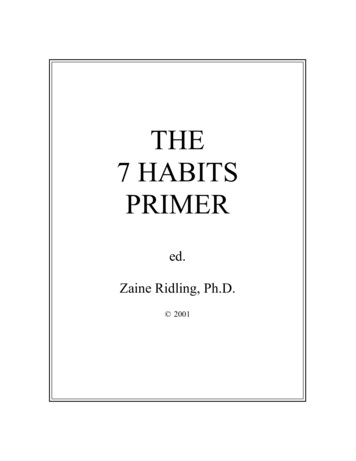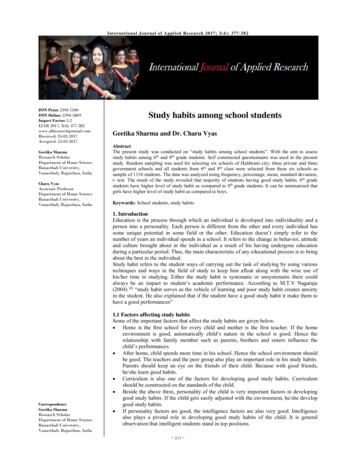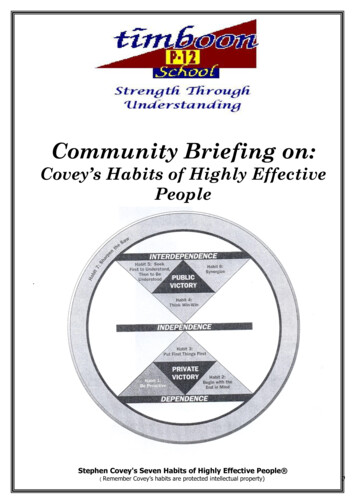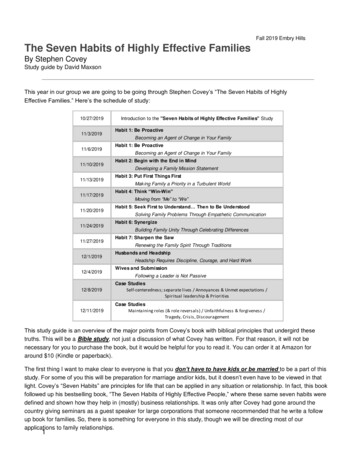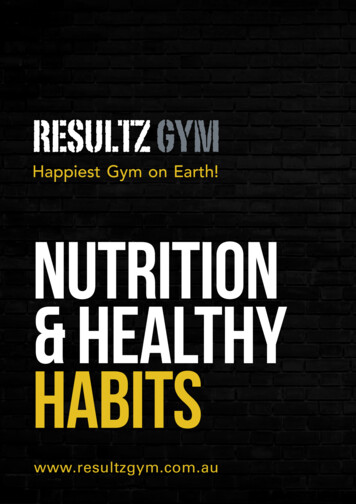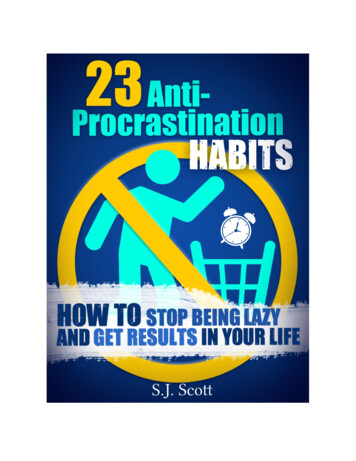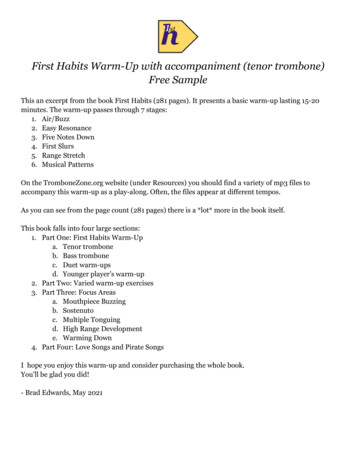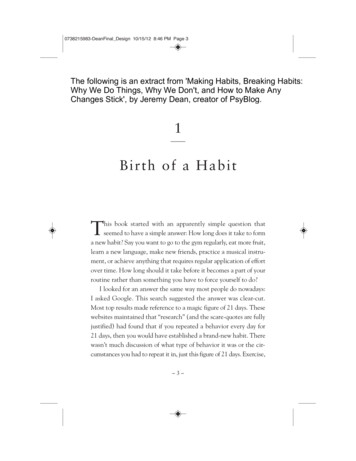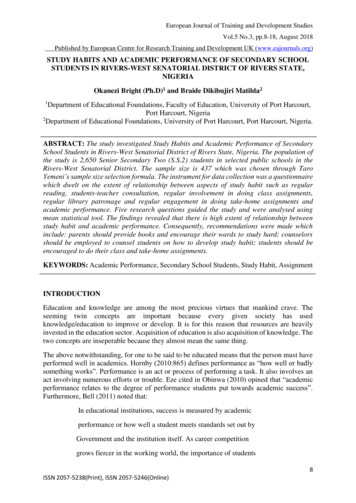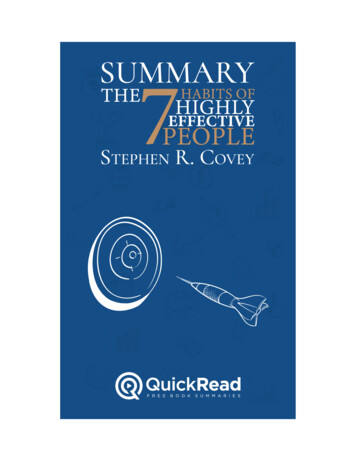
Transcription
Summary of «The 7 Habits ofHighly Effective People» byStephen R. CoveyWritten by Lea SchulleryThe perfect guide to adopting seven habits ofeffective people that can improve your life and thelives of those around you.
IntroductionEveryone wants to succeed. But what makes others succeed and others fail?First off, what defines success? While others may find that they have foundfinancial success, they may find that they are empty in other areas of lifesuch as in their relationships or in developing personal effectiveness.Through studying 200 years of literature, Covey found the concept ofsuccess has changed significantly over the years. While success was basedon character ethics like integrity, humility, and courage before 1920,success is now based on personality ethics like public image, attitude, andpersonality. To find true success and see true change, you won’t be able totake shortcuts. Instead, you will need to address the underlying conditionsand allow yourself to undergo a paradigm shift, change yourselffundamentally and adopt the seven habits of highly effective people.
Principles and ParadigmsThe 7 habits of highly effective people begins by looking inward andstarting from the inside-out. As a society, we attempt to create lives onsocial media that are aimed to portray happiness and near-perfection. Andconsidering social media is a mere highlight reel of a person’s life, we mayfind ourselves altering our appearances on the outside while strugglinginternally. Stephen Covey asks his readers to think about what they mostvalue in life, and imagine if everything were taken away tomorrow, whatwould you desire most? Will social media followers be on that list?Probably not.So how can identifying these values help you improve your life? Byimproving yourself from the inside-out. Before you can change your life,you must work on digging deep inside of yourself and identify yourfundamental habits and belief systems. These principles are at the core ofyour character and serve as a compass to guide you towards your goals.Perhaps your principles are concepts like fairness, honesty, and integrity.These are popular principles that guide our actions and lead to success;however, principles such as selfishness and deceit can lead to failure.Principles are laws of nature, and you reap what you sow; therefore, it’simportant to reflect on your core principles and determine if your characterguide is working with nature, or against it.Similar to following a map of a city to guide your way around, we follow ourparadigms to guide us in life. A paradigm is a subjective basis for how weview the world around us. Everything we understand about the world isformed by our paradigms. For instance, a person with a negative paradigmwill view a rainy day as gloomy and an inconvenience when going abouttheir day, but a person with a positive paradigm will view a rainy day as anopportunity for growth and provides nature with the sustenance needed forsurvival.
Shifting our paradigm is essential when seeking to make lasting changes.Once we shift our paradigms, then we can change our character, our habits,and our behaviors. This shift in character is why it’s important to recognizeand monitor your own paradigms so you can find out which ones areholding you back from reaching your goals. Author Stephen Coveyexperienced a paradigm shift one morning when on a New York Citysubway, a peaceful scene where most people were either reading or restingtheir eyes. Suddenly, a man entered with his rowdy children immediatelydisrupting the peace and serenity. Annoyed by this, Covey asked the man ifhe could control his children. The man, tired and exasperated, replied thathe should do something but their mother had just passed away an hourearlier and they were all in shock.Covey’s paradigm quickly shifted from irritated and annoyed to one ofcompassion with a desire to help. So you see, paradigm shifts can changeyour perspective about a situation, and while not all shifts will be asimmediate as the one Covey experienced that morning on the subway, theycan each make a powerful change in your life.So, unlike social media where you might work on covering your flaws andimperfections, this book will help you identify those qualities. Once youidentify your biggest problems in life, you will be able to view yourproblems from different angles and find their weaknesses. Working fromthe inside-out and changing your habits, you can improve your life.
Habit #1 - Be ProactiveImagine life is just a book with blank pages. If you had the opportunity towrite your own story, what would you want it to say? If your life were to endtoday, what would the book contain? Would the book contain stories of aperson who accomplished nothing because you were a victim of yourenvironment? Or would the book contain stories of a person who tookaction despite their physical environment?Here’s where we have our first principle. The principle of ownership. Wecan take control of our lives. It’s so easy to place blame on others for thestatus of our lives, but it becomes futile. “It’s not my fault” and “I had nocontrol over what happened” are common phrases that we say when wefind ourselves in sticky situations, but when we start to take ownership ofour lives, we adopt a new principle and our world begins to change. Theprinciple of ownership forces us to admit that we let ourselves go, but it alsoforces us to take ownership of the successes in our life. This paradigm shiftbegins the first habit: be proactive.People who are proactive take action. They take response-ability in their lifeand assume ownership. For instance, proactive people don’t wait for adiagnosis to make a healthy lifestyle change. They don’t wait for their bossto give them instructions, instead, they identify problems and come up withsolutions. They actively listen to the people in their lives and don’t wait fora fight to begin communicating effectively.To help you identify the difference between proactive people versus reactivepeople, imagine a Circle of Concern. This circle represents all the thingsthat you worry about. Maybe you’re worried about paying a bill or flyingacross the country. Inside the Circle of Concern is the Circle of Influencewhich represents all the things you can do something about. Reactivepeople focus on the Circle of Concern, unlike proactive people who focus onthe Circle of Influence.
By focusing on the things they can change, proactive people shrink theirCircle of Concern. One way to begin taking ownership is through language.Proactive people use words like “I will,” “I can,” and “I prefer,” whereasreactive people use “I can’t,” “I have to,” and “If only.” Reactive peoplebelieve they are not responsible for their actions and words. So, instead ofsaying things like “he makes me so mad,” shift your focus to “I control myown feelings” and begin converting reactivity into proactivity.Once you realize that you have a blank book to write, you can begin filling itwith what you want it to say. Focus on finding solutions instead of blamingoutside sources for your problems, and begin changing the way you react tothe problems in your life. Take responsibility, take ownership, and beginfilling your pages with stories of someone that took action.
Habit #2 - Begin with the End in MindImagine you are building a house from scratch. How would you begin thisprocess? You would first envision what you want the house to look like,right? You determine the layout of the house and then figure out everydetail. Construction workers would then follow the blueprint to beginbuilding. Without this blueprint, what mistakes could be made? Perhapsthey forget a key element, like stairs! Now, imagine your life as a blueprint.What is your end goal? What do you want to achieve? Planning is necessaryfor the success of any project, including your life. Here’s where thePrinciple of Direction comes in.To begin with the end in mind, you need direction. Just like building ahome, a direction is necessary for success. Effective people don’t just workhard and expect success to fall upon them, instead, they have a sense ofdirection in life. But how can you find that direction? Well, you can beginby imagining thirty days from now your friends and family are attendingyour funeral. What would you want those people to say about you? Whatare they saying about how you lived your life? By determining what youwant your friends and family to say about you helps you realize what yourlife is centered around. Perhaps you’re family-centered, money-centered,work-centered, or even self-centered. By imagining the end of life, you candetermine how you want to live.When answering these questions, you create your Personal MissionStatement which is the first step toward implementing habit 2. Yourmission statement is meant to serve as a compass and guide you to take thenecessary steps to ensure your personal success and happiness. However,writing a mission statement isn’t something that just comes overnight, itwill take time, patience and deep introspection. Similar to writing ablueprint, you will probably need to complete several rewrites.If you imagine your personal statement as the blueprint of your life, you canbegin to take action with purpose and intention. Just like each brick has a
purpose in building a house, your actions should have a purpose in helpingyou achieve your end goals.
Habit #3 - Put First Things FirstNow that you have determined your values and principles, how can youbegin taking action and living by those principles? By incorporating habit 3:Put first things first. How many times do you schedule out your week, butthen end up wasting time on things that aren’t important? You feel as if youhave no control over the several phone calls, meetings, and dailyinterruptions that hinder you from accomplishing your true goals. Perhapsyou try to incorporate time-management skills, but find that mosttechniques focus on efficiency, not effectiveness. So, how do you changethis? By prioritizing and ensuring the most important tasks are done first.Put everything else aside and get to those tasks later.While this sounds seemingly easy, you might find that you struggle todetermine which tasks are important and which are a waste of time.Luckily, Covey has a tool to help you figure that out. The Time ManagementMatrix is much more effective than just creating a to-do list of what needsto get done. By categorizing your tasks into urgency and importance, youcreate a 2 by 2 matrix. Quadrant One focuses on tasks that are both urgent and important.While this seems like a critical quadrant, this is more for tasks thatbecome outside of our control like crises that need to be dealt withright away. A deadline-driven project or the house burning down,can both fit into this quadrant.Quadrant Two focuses on tasks that are important, but not urgent.This is the most critical quadrant, as these are the tasks that are mostimportant to us. These tasks include building relationships orplanning for the future, these are important principles that will nothappen overnight. Spend your time taking action that focuses onbuilding upon the tasks you put into quadrant two. For instance, ifyou want to improve your relationships, take the time to call a friendor family member on your car ride home versus listening to music oryour favorite podcast.
Quadrant Three focuses on tasks that are not important but areurgent. These tasks are those that interrupt our days, such as phonecalls or meetings. If you find yourself prioritizing tasks in quadrantthree, you end up responding to tasks that are based on the prioritiesof others, not yourself. This can lead to several consequences likeshort-term focus or feeling like your life is out of control.Quadrant Four focuses on tasks that are neither important norurgent. These tasks include those that are a complete waste of timelike watching an entire series of Netflix in one day or mindlesslyscrolling social media while at work. These tasks lead to a life ofcomplete dependence and cause people to get fired from jobs.So why focus on quadrant two? As mentioned previously, these are tasksthat are most important to us. They focus on building relationships,planning, exercising, and preparation. All things that are critical to yourhappiness, but you set them aside because you think you don’t have thetime for them. But how can you make time for them? By learning to say noto other activities. Say no to activities that even seem urgent at the time andlearn how to delegate effectively.By prioritizing quadrant 2, you begin to approach your tasks through theinside-out. You begin with your solid core of principles, and once problemsarise, you begin to see them as pieces of a whole versus a whole itself. Forinstance, when working with shopping-center managers, Covey realizedthat while the managers knew building relationships with store owners wasimportant and would have a positive impact, they spent less than 5% oftheir time doing it. Instead, managers spent most of their time on quadrantone tasks like answering phone calls and emails, attending meetings, andwriting reports. Wanting to implement a change, the managers devoted athird of their time to building relationships with store owners and theimpact was huge. Managers saw an increase in satisfaction and leaserevenue. The managers prioritized quadrant two and shifted theirperceptions of quadrant one as just pieces of the puzzle, and said no to thetasks that were not important.
If you want to begin implementing habit three, the best way to begin is bycreating your own matrix and identifying the tasks in quadrant two that youhave been neglecting. Commit to working on quadrant two in writing andbegin prioritizing your actions.
Habit #4 - Think Win-WinLife is a dog-eat-dog world. It’s about fierce, ruthless competition and if youhave to lie and cheat to get what you want, then so be it. Do you believethat? Is life actually a dog-eat-dog world? If you’re having to lie and cheat,aren’t you going against your principles of honesty and integrity?Unfortunately, this is a mindset that many people possess in today’ssociety. They believe that to win, you have to lose. But what if I told you thatlife doesn’t have to be that way? Instead, life doesn’t have to be acompetition, both parties can win. By creating a win-win mindset, you canbegin to establish successful, interdependent relationships.Adopting a win-win mindset might mean shifting your paradigm of humaninteraction. In fact, there are 6 paradigms that Covey explains. The first is the Win-Win paradigm in which both people win.Problems are resolved by creating a mutually beneficial solution thatsatisfies both parties. The second is the Win-Lose paradigm in which people think “If Iwin, you lose.” Win-lose people use their power, position, andcredentials to influence others to get what they want. The third is the Lose-Win paradigm in which people think “If I lose,you win.” Lose-win people aim to please those around them and seekpopularity and acceptance. The fourth is the Lose-Lose paradigm in which both people lose.Whenever two “win-lose” people or two determined, stubborn, andego-driven people negotiate with one another, it will always end in alose-lose situation. The fifth is the Win paradigm in which people simply don’t care whatthe outcome is for the other party as long as they win.1. The final paradigm is the Win-Win or No Deal mindset in whichpeople believe if a mutually beneficial agreement cannot be made,then no deal will be made.
When trying to find a solution, the most important thing is to be consciousof finding one that stays in line with your principles. This is an example ofthe Principle of Abundance. The Principle of Abundance embraces anAbundance Mentality which means you believe there is more than enoughfor everyone. Those that don’t have an Abundance Mentality instead have aScarcity Mentality and believe that if you win, then another person has tolose. In other words, they have the “this town ain’t big enough for the bothof us” mentality.If you think win-win, you’ll eventually find yourself building positiverelationships because you’ll end up strengthening both parties rather thanslowly destroying one. A good exercise to begin thinking about how you canimplement this mindset is by identifying a relationship that you have thatcould benefit from a win-win solution. Now put yourself in the otherperson’s shoes and write down the solutions the other person wouldconsider a win. Now write down what you consider a win. Try and come upwith a solution that incorporates wins that mutually benefit each party.
Habit #5 - Seek First to Understand, Then toBe UnderstoodImagine going to the optometrist and explaining to the doctor that you’restruggling to see signs that are far away. Then, the optometrist takes off hisown glasses and hands them to you saying “These have worked for me foryears! Try them on, they should work for you!” No questions asked, no testsare done, the doctor just offers a simple solution that most likely won’thelp. You wouldn’t go back to that doctor, you can’t trust him.Now think about yourself going through a trying time in life: divorce, thedeath of a loved one, the loss of a job. Who do you seek advice from?Someone that has never been in your shoes and can’t possibly understandwhat you are going through, or someone that understands your situation?Someone that understands! You trust people that listen to you and yourespect their advice.Whether it’s a doctor or a friend, you trust people that understand whatyou’re going through and a key to understanding is through listening. If thedoctor listened to you, he would know better how to help you rather thanjust giving you a random pair of glasses to solve your problems. Speaking oflistening, the most effective form of listening is emphatic listening whichrequires a paradigm shift to achieve. You see, we don’t typically seek tounderstand first, instead, we seek to be understood. At any given moment, aperson is either speaking or preparing to speak, rather than preparing tounderstand.According to experts in communication, only 10% of our communication isrepresented by words. 30% is represented by sounds and 60% is accountedfor by our body language. If we replace our typical responses with emphaticlistening, you will see that you shouldn’t necessarily focus on words to trulyunderstand the other person. Instead, you should observe a conversationthrough feeling and meaning behind the words that are said. With wordsremoved, what emotions are being conveyed?
While this skill takes time and practice, it’s certainly not impossible to learnhow to listen emphatically. Once you master the skill of seeking tounderstand, then you can focus on being understood. When we trulyunderstand the other person, we can adequately communicate and presentour ideas in a way that builds credibility and trust rather than tearing theother person down.
Habit #6 - SynergizeEveryone is different, right? The world would be a pretty boring place if weall thought similarly and we couldn’t learn from one another. In fact, weneed one another. In the previous chapter, we discussed understanding andlistening to each other for effective communication. Now, we can focus onworking with one another through the Principle of Team Execution, theprinciple that we need each other to thrive, and that both independenceand interdependence are necessary for productive interactions.By understanding and valuing the differences of another’s perspective, youcreate the opportunity for synergy. Synergy is a concept that the combinedvalue of each individual will be greater than if each individual remainedindependent. In other words, two heads are better than one. While eachperson thinks differently, each person offers something that can benefit thegreater good. Synergy allows you to open yourself up to new opportunitieswith endless possibilities. Synergy allows you to listen to one another’sdifferences and determine how to come together to tackle a sharedchallenge.So how can you begin to synergize with your team? Begin with habits 4 and5 and think about win-win situations while trying to truly understandothers around you. By valuing the different perspectives and opinions thateach person has, you can begin to build something greater than yourself.For instance, a great movie isn’t created by one person. Look at movies likeLord of the Rings or Star Wars. Without a team of creators, designers,writers, and more, the movies would never come to life as they do. Eachteam member has their own strengths that they bring to the table thatbenefits the project as a whole. By valuing the mental, emotional,psychological differences between people, you can begin synergizing andcreating something bigger than you ever could on your own.Beginning to value these differences takes time and patience especiallywhen there are people in your life that you don’t get along with. But why
don’t you get along? You might think differently than that person, so howcan you begin to open yourself up to these differences? Start by creating alist of people that you don’t get along with. Choose just one person anddetermine how their views are different than yours. How can you findsynergy between your perspective and theirs? How can you be more openminded and confident about their differences?
Habit #7 - Sharpen the SawChefs use their knives every day, they constantly chop, slice, and diceeventually making their knife dull. Do they just throw the knife away andbuy a new one? No, they sharpen it. Just like a chef’s knife, we have tosharpen ourselves as well. We must devote time to ourselves physically,spiritually, mentally, and socially. By sharpening your saw in these fourareas, you can see the results for lasting effectiveness.Renewing yourself physically means eating well, getting sufficient rest, andexercising regularly to build flexibility, endurance, and strength. Stayingphysically active helps to sharpen habit one of proactivity. You have tobecome proactive towards your fitness rather than reacting to the forcesthat keep you from exercising.Focusing on your spiritual dimension doesn’t necessarily mean adopting aspecific religion at all, instead, it means that you should examine your lifeand be mindful of your actions. The goal of renewing your spiritual self caninclude meditating, praying, or connecting with nature. SpiritualDimension can help you practice habit two since you consistently reviseyour principals and core values.To stay mentally healthy, you can read great books, keep a journal of yourthoughts and insights, and limit television programs to only watching thosethat enrich your life and mind. You can also learn a new language, or takecourses to learn something new. There are a variety of ways to enrichyourself mentally. Additionally, focusing on mental health will help youpractice habit three since you’ll be utilizing your time management skills tomaximize your time and resources.Lastly, it’s important to work on your social and emotional health.Renewing yourself socially to develop meaningful relationships means youmust seek to understand others, make contributions to meaningful projectsthat improve the lives of others, maintain an Abundance Mentality and help
others achieve their own success. By working on your social and emotionalhealth, you are practicing habits 4, 5, and 6 by adopting a win-win mindset,seeking to understand others, and finding mutually beneficial solutionsthrough synergy.If you’re wondering how you can work on these four dimensions, begin bymaking a list of activities that will help you renew yourself among eachcategory. Select one activity from each dimension and commit tocompleting that activity next week. At the end of the week, evaluate yourperformance and question what led to your success or failure.
Final SummaryTo become a highly effective person, you must adopt these seven habits: Be proactive. Stop reacting and begin taking action. Instead, takecontrol and assume responsibility for your life. Begin with an end in mind. Stop working aimlessly on whatever jobpops up. Instead, have a vision for your future, and align youractions to make that vision a reality. Put first things first. Stop wasting your time on tasks that seemurgent at the moment, but don’t align with your goals. Instead,prioritize your tasks and focus on the non-urgent, important items. Think win-win. Stop thinking that you must win or lose. Instead,come up with a mutually beneficial solution for both parties. Seek first to understand, then to be understood. Stop jumping toprovide a solution or a response. Instead, listen emphatically tounderstand others around you, then communicate ideas that alignwith another’s feelings. Synergize. Stop working independently. Instead, use the strengths ofothers around you to create something you could have never createdby yourself. Sharpen the saw. Stop working too hard. Instead, continue to workon yourself mentally, physically, spiritually, and socially.
Author Stephen Covey experienced a paradigm shift one morning when on a New York City subway, a peaceful scene where most people were either reading or resting their eyes. Suddenly, a man entered with his rowdy children immediately disrupting the peace and serenity.


